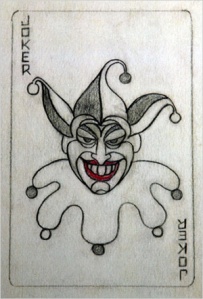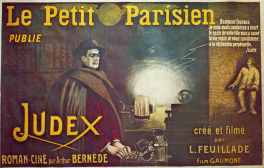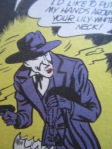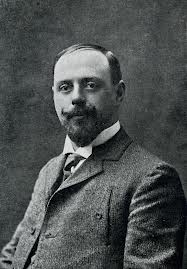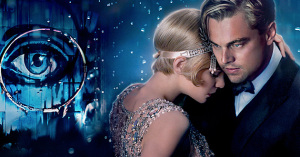Who created the Joker?
Standard answers boil down to some combination of Bob Kane and his assistants, writer Bill Finger and artist Jerry Robinson. According to Kane though, Robinson “had absolutely nothing to do with it” because Robinson’s contribution—the Joker playing card used in Batman No. 1—was added after Kane and Finger already thought up the character. Robinson, however, claimed “the concept was mine,” including both the playing card and the “outline of the persona and what should happen in the first story.”
They were both wrong.
The Joker was Finger’s idea, and I know because he stole it.
Kane and Robinson agree that Finger handed Kane a photograph of Conrad Veidt from the 1928 film adaptation of Victor Hugo’s The Man Who Laughs which Kane used to draw the Joker. A clown-faced ad for a Coney Island attraction has gotten some credit too. But Finger’s kept his primary source hidden.
The Joker’s first appearance begins with a death threat: “Tonight at precisely twelve o’clock midnight I will kill Henry Claridge…”
Henry Claridge, frantic with fear, calls the police.
CLARIDGE: “You’ve got to protect me!”
POLICE CHIEF: “Don’t worry, Mr. Claridge.”
Time drags on—seconds minutes— then the fatal hour twelve o’clock.
CLARIDGE: “I’m still alive! I’m not dead! I’m safe! I’m SAAAAGH! Aaghh!”
The Joker has fulfilled his threat. Claridge is dead!! Slowly the facial muscles pull the dead man’s mouth into a repellent ghastly grin. The sign of death from the Joker!
CHIEF: “It’s—it’s horrible!”
OFFICER: “Grotesque! The Joker brings death to his victims with a smile!”
The Joker repeats the pattern a page later:
“At ten o’clock that fiend will kill Jay Wilde!”
The toll of time—the fatal hour!
BONG! BONG!
WILDE: “Ten! It’s going to happen now! The clock is ticking my life away!”
A strangled scream—death!
JOKER: “Are you so happy that you smile for joy, eh? I’m glad I have brought you so much cheer!”
My son was ten the first time he flipped through my Batman Chronicles reprint, half the age of students in my superhero class who looked equally disturbed. It struck a nerve in 1940 too. Kane’s DC editors rescued the Joker from death to keep a recurring character—one who would become the most famous supervillain in comic books.
But he wasn’t new to pulp fiction. His first joke was published a quarter century earlier:
Cocantin had just noticed that Favraux held in his hands a yellow envelope similar to the one that contained Judex’s earlier message.
The banker unsealed it. Scanning every word, he read it aloud:
“If before the stroke of ten tonight, you don’t relinquish half of your ill-gotten fortune to the Public Assistance, it will be too late. You will be punished mercilessly.”
And it was signed: JUDEX!
“The joke continues,” emphasized Cocantin with a humorous smile.
“It has lasted for too long,” scolded the banker while raising his eyebrows.
“Don’t be upset, Monsieur Favraux,” implored Cocantin. “. . . .This sinister joke will soon collapse due to my efforts. . . . I reassure you, Monsieur. I will look after you!”
. . . The monumental clock on one of the room’s panels displayed two minutes before ten o’clock. . . . Instinctively, his eyes sought the clock. The hands had almost reached the time foretold by Judex. . . . Fear shook his mortal frame. . . .
The clock struck ten o’clock. Favraux’s face contracted in a hideous convulsion. . . . As a frightful moan escaped his throat, he collapsed. He had been struck down!
Judex had kept his word!
In the commotion, guests ran to Favraux’s side. . . . The facial features of the gilded banker were frozen in a grotesque grimace of superhuman fright.
Swap a few names–“the Joker” and “Judex,”“Favraux” and “Claridge” or “Wilde,” “Cocantin” and the Police Chief—and the scene is the same as the ones in Batman No. 1. Except it was written in 1916 when Bill Finger was only two years old. It’s by Arthur Bernéde from his novelization of director Louis Feuillade’s film serial Judex. The French magazine Le Petit Parisien published installments with the theatrical release of each weekly chapter.
Feuillade’s previous serial had brought the villain Fantomas to screen, but the title character of Judex—often cited as an influence on the cloaked and slouch-hatted Shadow who in turn influenced Batman—is the hero, a “judge” taking revenge on a corrupt banker (who, we later learn, isn’t really dead). When Finger supplied his boss with the Veidt photo, he was filling in details for “the joker” of Bernéde’s text.
It’s possible Robinson drew his playing card independently—stranger coincidences happen. It’s a greater leap to think Robinson handed it to Finger first, triggering Finger’s memory of the “joke” in Judex. Either way, Bernéde’s contribution outweighs all others. Kane even drew him with Judex’s hat and white face of the 1916 magazine illustration.
I have no idea if Bill Finger ever saw Judex, but according to Robinson he was a voracious reader “who spent lots of time doing research.” Robinson also called him his “cultural mentor,” describing him as “extremely well read” and a “student of pulps and radio drama” as well as “Dumas and Shakespeare.”
Bernéde and Feuillade, avid researchers themselves, read Alexander Dumas too. Judex’s destruction of Favraux’s ill-gotten fortune as well as imprisoning him until he acknowledges his wrong-doing—that’s the Cliff Notes version of The Count of Monte Cristo, the fate suffered by one of the three men who falsely imprisoned Dantès before he assumed the guise of the vengeance-seeking Count.
But neither Dumas nor Feuillade originated Bernéde’s joker scene. The silent picture includes little of the banker and the detective’s dialogue (neither of the “joke” references) and when Favraux collapses on screen, Feuillade supplies no close-up. The “grotesque grimace” exists only in Bernéde’s novelization, the version of Judex Finger could have easily accessed.
Bernéde figures in Batman’s origin too. When Kane needed an explanation for his hero’s “lone battle against the evil forces of society,” Bill Finger retconned a pair of murdered parents and a vow of vengeance. “I swear by the spirits of my parents,” cries the kneeling Bruce Wayne, “to avenge their death by spending my life warring on criminals.” The young Judex kneels before his own father’s body, as his surviving mother demands the same vow: “your father was murdered by a crook named Favraux. Swear before him that you will avenge his death . . . .”
This isn’t the first time Finger borrowed heavily from another writer. Will Murray details Finger’s use of Theodore Tinsley’s 1936 Shadow novella, Partners of Peril, for Bat-man’s first adventure in Detective Comics No. 27. “Finger did not simply draw inspiration from this thunderous tale,” writes Murray, “he adapted it outright! It’s the same story . . . . Only the character names have been changed.”
The Joker’s real name is Arthur Bernéde.

